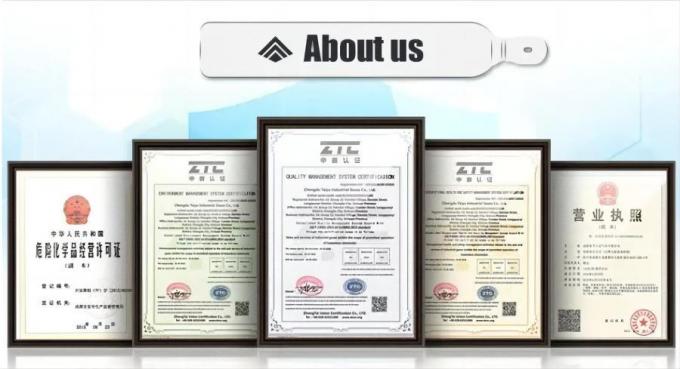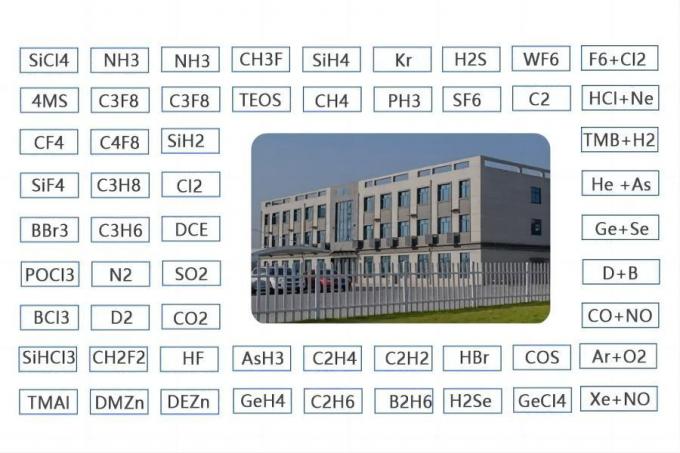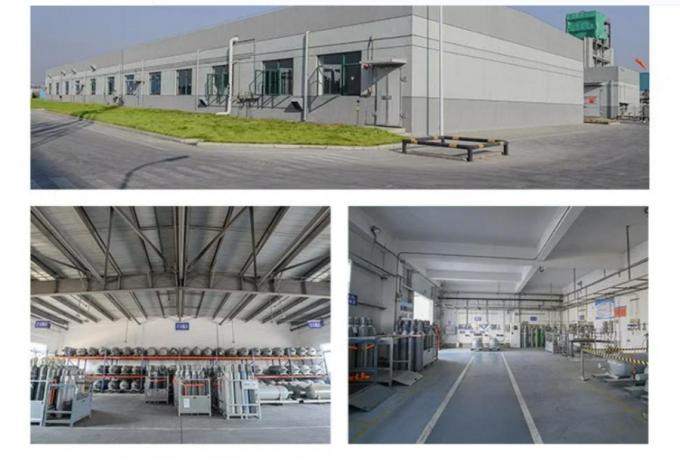


| MOQ: | 1 m3 |
| Price: | US $3/m3 |
| Standard Packaging: | Cylinder |
| Delivery Period: | 15 days |
| Payment Method: | L/C, T/T |
| Supply Capacity: | 1000Tons/year |
Oxygen gas (O2) is a colorless, odorless, and tasteless gas that is essential for supporting life on Earth. It is one of the most abundant elements in the Earth's atmosphere, making up approximately 21% of the air we breathe. Here are some key points about oxygen gas:
Chemical Composition: Oxygen gas is composed of two oxygen atoms bonded together (O2). It is a diatomic molecule.
Occurrence: Oxygen is a highly abundant element on Earth. In the atmosphere, it exists primarily in the form of diatomic oxygen (O2). It is also found in various compounds, such as water (H2O), carbon dioxide (CO2), and minerals.
Role in Life Processes: Oxygen is vital for supporting life and the functioning of many biological processes:
Respiration: Oxygen is essential for aerobic respiration, the process by which living organisms convert nutrients into energy. During respiration, oxygen is used to break down glucose and other molecules, releasing energy and producing carbon dioxide as a waste product.
Combustion: Oxygen supports combustion, providing the necessary chemical reactions for burning and oxidation processes.
Industrial and Medical Applications: Oxygen gas has various industrial and medical applications:
Medical Use: Oxygen is commonly used in medical settings to assist patients with breathing difficulties. It can be administered through oxygen masks, nasal cannulas, or specialized medical equipment.
Welding and Cutting: Oxygen is often used as an oxidizer in welding and cutting processes. It supports the combustion of fuel gases, such as acetylene, to generate high temperatures for metal joining and cutting.
Chemical Manufacturing: Oxygen gas is an important reactant in the production of various chemicals, including acids, fertilizers, plastics, and explosives.
Oxy-fuel Combustion: Oxygen-enriched air or pure oxygen is used in certain industrial processes, such as glass manufacturing and steel production, to enhance combustion and increase process efficiency.
Environmental Applications: Oxygen can be used in wastewater treatment processes to enhance microbial activity and facilitate the breakdown of organic matter.
Safety Considerations: While oxygen is essential for life, it is important to handle and store oxygen gas properly:
Fire and Explosion Hazard: Oxygen supports combustion, so it can intensify fires and increase the risk of explosions. Care should be taken to prevent the presence of flammable materials or open flames in oxygen-enriched environments.
Oxygen Concentration: Oxygen concentrations above normal levels in the atmosphere can increase the risk of rapid combustion and make materials more flammable. Oxygen should be used or stored in designated areas with proper ventilation and safety measures.
Handling and Storage: Oxygen cylinders and equipment should be handled with care to avoid damage or leaks. Proper training and adherence to safety guidelines are necessary for the safe storage, transport, and use of oxygen gas.
Understanding the properties and safe handling of oxygen gas is important to ensure its proper use in various applications and to maintain a safe working environment.
| Transport Package: | 40L/47L/50L/ISO Tank | Melting Point | -218.4 ºC |
| Trademark: | CMC | Boiling Point | -183 ºC |
| Specification | 99.999% | Production Capacity | 100, 000m3/Year |
| Cylinder Pressure | 12.5MPa/15MPa/20MPa | Valve | Qf-2/Cga580 |
| Appearance | Colorless, Odorless | Density | 1.429g/L |
Specification:
CAS No.: 7782-44-7
EINECS No.: 231-956-9
UN No.: UN1072
Purity: 99.999%-99.9999%
Dot Class: 2.2 & 5.1
Appearance: Colorless
Grade Standard: Industrial Grade, Grade, Electronic Grade
| Specification | 99.999% |
| Hydrogen | ≤0.5 ppm |
| Argon | ≤2 ppm |
| Nitrogen | ≤5 ppm |
| Carbon Dioxide | ≤0.5 ppm |
| THC (as CH4) | ≤0.5 ppm |
| Moisture | ≤2 ppm |
| Cylinder Specifications | Contents | Pressure | ||
| Cylinder Capacity | Valve | Volume | bar | psig |
| 40L | QF-2 | 7 m3 | 150 | 2175 |
| 47L | QF-2 | 7 m3 | 150 | 2175 |
| 50L | QF-2 | 10 m3 | 200 | 2900 |




| MOQ: | 1 m3 |
| Price: | US $3/m3 |
| Standard Packaging: | Cylinder |
| Delivery Period: | 15 days |
| Payment Method: | L/C, T/T |
| Supply Capacity: | 1000Tons/year |
Oxygen gas (O2) is a colorless, odorless, and tasteless gas that is essential for supporting life on Earth. It is one of the most abundant elements in the Earth's atmosphere, making up approximately 21% of the air we breathe. Here are some key points about oxygen gas:
Chemical Composition: Oxygen gas is composed of two oxygen atoms bonded together (O2). It is a diatomic molecule.
Occurrence: Oxygen is a highly abundant element on Earth. In the atmosphere, it exists primarily in the form of diatomic oxygen (O2). It is also found in various compounds, such as water (H2O), carbon dioxide (CO2), and minerals.
Role in Life Processes: Oxygen is vital for supporting life and the functioning of many biological processes:
Respiration: Oxygen is essential for aerobic respiration, the process by which living organisms convert nutrients into energy. During respiration, oxygen is used to break down glucose and other molecules, releasing energy and producing carbon dioxide as a waste product.
Combustion: Oxygen supports combustion, providing the necessary chemical reactions for burning and oxidation processes.
Industrial and Medical Applications: Oxygen gas has various industrial and medical applications:
Medical Use: Oxygen is commonly used in medical settings to assist patients with breathing difficulties. It can be administered through oxygen masks, nasal cannulas, or specialized medical equipment.
Welding and Cutting: Oxygen is often used as an oxidizer in welding and cutting processes. It supports the combustion of fuel gases, such as acetylene, to generate high temperatures for metal joining and cutting.
Chemical Manufacturing: Oxygen gas is an important reactant in the production of various chemicals, including acids, fertilizers, plastics, and explosives.
Oxy-fuel Combustion: Oxygen-enriched air or pure oxygen is used in certain industrial processes, such as glass manufacturing and steel production, to enhance combustion and increase process efficiency.
Environmental Applications: Oxygen can be used in wastewater treatment processes to enhance microbial activity and facilitate the breakdown of organic matter.
Safety Considerations: While oxygen is essential for life, it is important to handle and store oxygen gas properly:
Fire and Explosion Hazard: Oxygen supports combustion, so it can intensify fires and increase the risk of explosions. Care should be taken to prevent the presence of flammable materials or open flames in oxygen-enriched environments.
Oxygen Concentration: Oxygen concentrations above normal levels in the atmosphere can increase the risk of rapid combustion and make materials more flammable. Oxygen should be used or stored in designated areas with proper ventilation and safety measures.
Handling and Storage: Oxygen cylinders and equipment should be handled with care to avoid damage or leaks. Proper training and adherence to safety guidelines are necessary for the safe storage, transport, and use of oxygen gas.
Understanding the properties and safe handling of oxygen gas is important to ensure its proper use in various applications and to maintain a safe working environment.
| Transport Package: | 40L/47L/50L/ISO Tank | Melting Point | -218.4 ºC |
| Trademark: | CMC | Boiling Point | -183 ºC |
| Specification | 99.999% | Production Capacity | 100, 000m3/Year |
| Cylinder Pressure | 12.5MPa/15MPa/20MPa | Valve | Qf-2/Cga580 |
| Appearance | Colorless, Odorless | Density | 1.429g/L |
Specification:
CAS No.: 7782-44-7
EINECS No.: 231-956-9
UN No.: UN1072
Purity: 99.999%-99.9999%
Dot Class: 2.2 & 5.1
Appearance: Colorless
Grade Standard: Industrial Grade, Grade, Electronic Grade
| Specification | 99.999% |
| Hydrogen | ≤0.5 ppm |
| Argon | ≤2 ppm |
| Nitrogen | ≤5 ppm |
| Carbon Dioxide | ≤0.5 ppm |
| THC (as CH4) | ≤0.5 ppm |
| Moisture | ≤2 ppm |
| Cylinder Specifications | Contents | Pressure | ||
| Cylinder Capacity | Valve | Volume | bar | psig |
| 40L | QF-2 | 7 m3 | 150 | 2175 |
| 47L | QF-2 | 7 m3 | 150 | 2175 |
| 50L | QF-2 | 10 m3 | 200 | 2900 |


